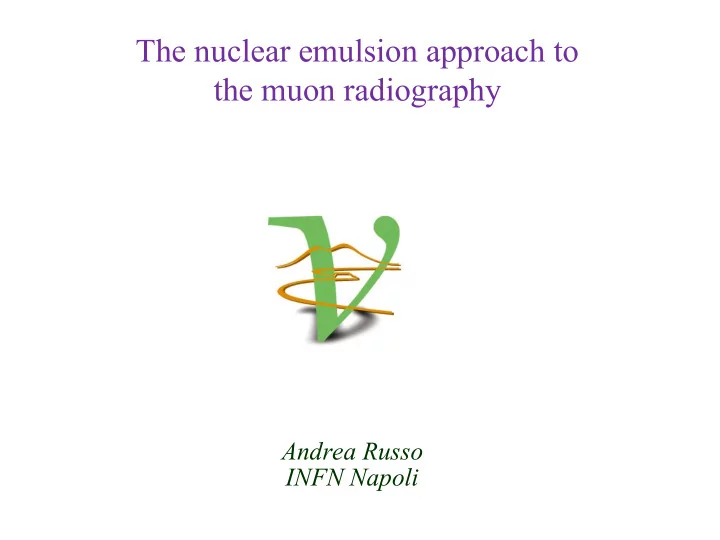

The nuclear emulsion approach to the muon radiography Andrea Russo INFN Napoli
Nuclear emulsion films Made of AgBr crystals poured in an organic gelatine. Passage of charged particles mip can be recorded with accuracy better than 1micrometer charged particles crossing emulsions fog ionize AgBr crystals. Fixing and development turn ionization points into black grains Compton electron A track is defined as a sequence of About 35grains/100microns aligned black grains on OPERA-like emulsions (optimized for detection of m.i.p. particles) 2
Emulsion Scanning Principle Tracking in emulsion layer OPERA-like emulsion 300 µ m Tomographic scanning of emulsuion to identify ionized grains → processed to identify 3d tracks 3
High speed automated emulsion scanning Two approaches ESS (European Scanning System) SUTS (Super Ultra Track Selector) • High speed CCD camera (3 kHz), • Customized commercial optics Piezo-controlled objective lens and mechanics • FPGA Hard-coded algorithms • Asynchronous DAQ software 4
Emulsion films as tracking detectors Films exposed orthogonal to the beam µ plastic base Angular resolution: from ≅ 2 to a few mrad depending on track angle emulsion film 300 µm Micrometric position resolution 5
Emulsion films as tracking detectors (2) Highly modular structure: detection surface easily scaled to fit requirements, flexible detector geometry Emulsion detector at Unzen volcano 1mm- thick rubber Basic module: emulsion film Muon 12.5 · 10.0 cm 2 from 300 micron thick Lava dome Easily portable No need for electric power supply Stainless steel 3mm thickness Suited for outdoor sites 6
Emulsion telescope at Stromboli micro-tracks µ Steel plastic base 3mm 3mm 3mm (not to scale) emulsion layers emulsion film 300 µm 44 µm 4 emulsion films / 8 emulsion layers / 8 micro-tracks Few mrad resolution Redundant tracking for background rejection Low momentum particle rejection by multiple scattering analysis 7
Issues in emulsion film analysis Detector surface issue: Detection surface limited by scanning power: present limits: ≅ 0.02 m 2 /day/microscope (ESS system) New generation microscope (10 times faster) under development Timing issue: Emulsion integrate ionizing radiation anytime from production to development, no timing information available: dedicated analysis to separate “transportation background” from exposure signal need for shielding from radioactive background to keep emulsion films “clean” 8
Issues in emulsion film analysis Temperature issue: Ionizing radiation creates a latent image in emulsion films, fixed and developed by chemical treament. Latent image rapidly fades away before development at temperature above ≅ 20° Thermic insulation at Stromboli site. Emulsion exposure done in autumn-winter 9
SPARES
High speed automated emulsion scanning Two approaches EU: ESS (European Scanning System) Japan: SUTS (Super Ultra Track Selector) • Scanning speed/system: 75cm 2 /h • Scanning speed/system: 20cm 2 /h • High speed CCD camera (3 kHz), • Customized commercial optics Piezo-controlled objective lens and mechanics • FPGA Hard-coded algorithms • Asynchronous DAQ software 11
Recommend
More recommend